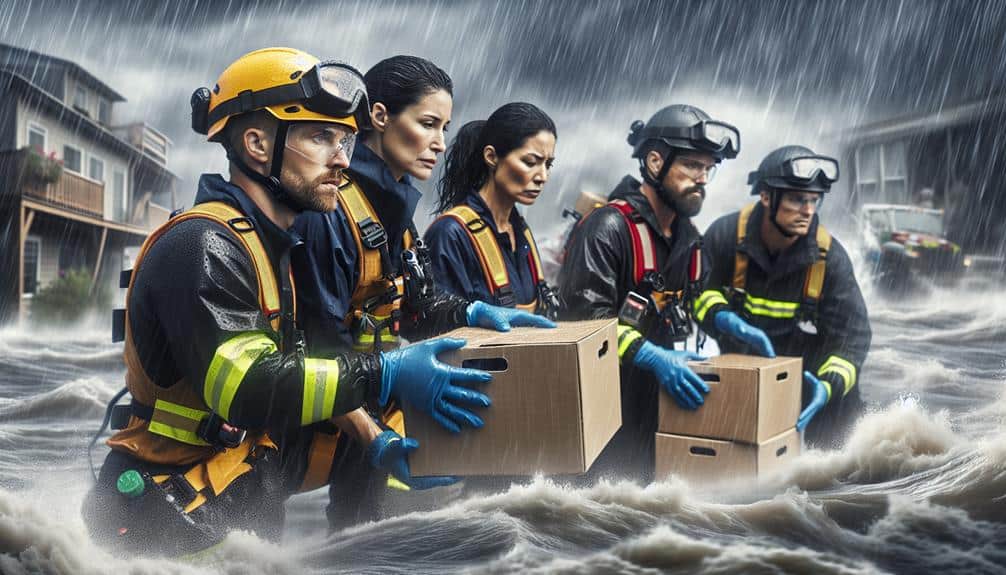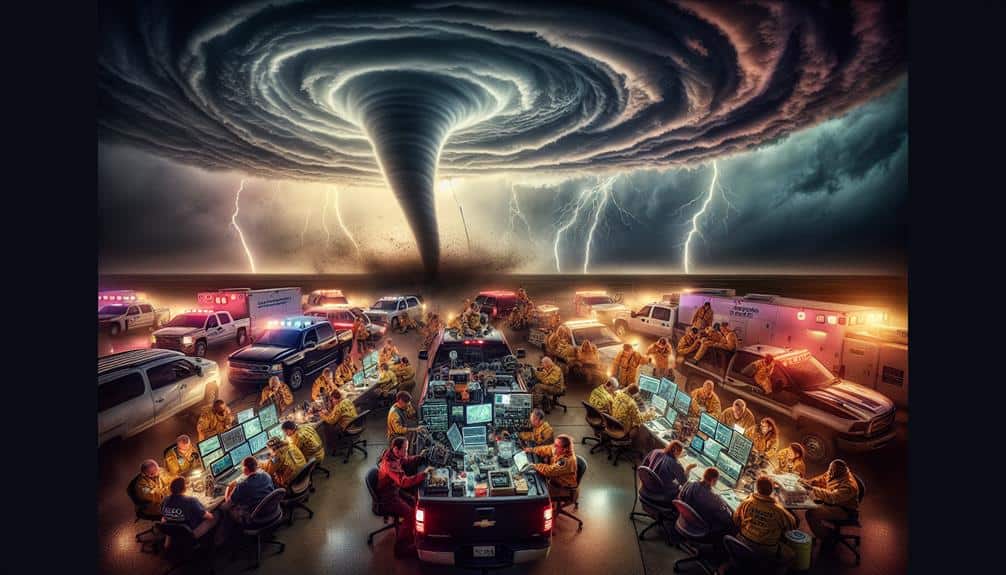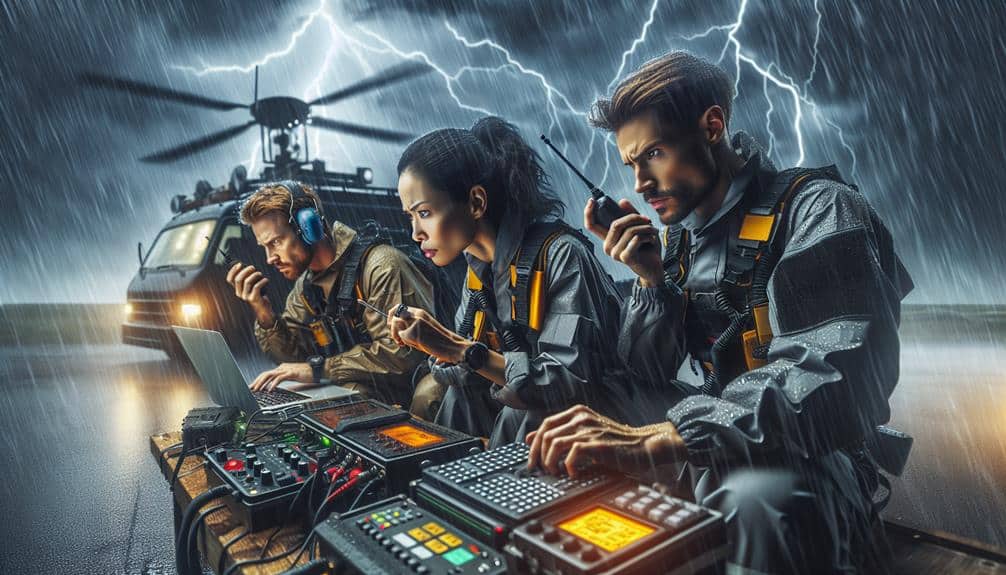We've devised successful coordination strategies for extreme weather events by concentrating on robust communication protocols and real-time data sharing. Utilizing advanced sensors and cloud-based systems, we guarantee smooth information flow and agile decision-making. Prioritizing resource management and pre-positioning teams in hotspots reduces response times noticeably. Proactively planning evacuation routes and involving communities through regular drills keeps everyone prepared. Post-event, we rigorously analyze data and feedback to improve our strategies. Together, these measures create a dynamic response network that maximizes safety and efficiency. Learn more about our thorough approach to addressing extreme weather challenges.
Key Points
- Implement seamless real-time communication protocols across multiple platforms for timely notifications and organized responses.
- Utilize advanced sensors and IoT devices for real-time monitoring and informed decision-making.
- Prioritize resource distribution based on population density and vulnerability to ensure effective relief.
- Pre-position and dynamically deploy teams to reduce response time and maximize impact.
Communication Protocols
Effective communication protocols are essential for coordinating responses during extreme weather events. When a storm hits, our team communication must be seamless and immediate. We can't afford delays or misunderstandings, as they could lead to severe consequences. Establishing clear channels for team communication helps us stay organized and responsive. We need to make sure everyone on the team knows their role and how to relay information efficiently.
Emergency notifications are another critical component. Real-time alerts should inform both our team and the public about imminent threats. These notifications must be precise, concise, and actionable. We should leverage multiple platforms—SMS, email, social media—to guarantee the widest possible reach. This redundancy minimizes the risk of communication failure and ensures that warnings are received promptly.
Strategically, we must evaluate and refine our communication protocols regularly. Drills and simulations can identify weaknesses in our system, allowing us to address them before an actual emergency. By doing this, we maintain our readiness and improve our ability to respond effectively.
Ultimately, our goal is to empower everyone involved with the information they need to act swiftly and decisively, safeguarding lives and property in the process.
Data Sharing Techniques
As we refine our communication protocols, we must also focus on robust data sharing techniques to guarantee timely and accurate information flow during extreme weather events. Real-time monitoring is crucial for effective decision-making. By leveraging advanced sensors and IoT devices, we can collect and disseminate live data on weather patterns, infrastructure status, and resource availability. This immediate access to information empowers us to make informed, swift decisions that could save lives and minimize damage.
Equally important is our use of collaboration platforms. These digital tools facilitate seamless information exchange among various stakeholders, including emergency services, government agencies, and community organizations. Through cloud-based systems, we can ensure that data isn't just shared, but also analyzed collectively, fostering a unified response strategy. Integrating real-time monitoring with sturdy collaboration platforms enables us to create a dynamic, interconnected network that keeps everyone on the same page.
Moreover, these platforms offer the flexibility and autonomy our audience craves. By setting up customizable dashboards and alerts, each team can prioritize the data most relevant to their specific operations. This tailored approach guarantees that our response remains agile and effective, even in the face of unpredictable weather conditions.
Resource Allocation
Frequently, we must prioritize resource allocation to make sure that important supplies and personnel are directed where they're needed most during extreme weather events. Effective resource allocation isn't just about having enough resources; it's about deploying them strategically to maximize impact and guarantee swift relief.
To achieve this, we focus on several key areas:
- Shelter distribution: Identifying and equipping shelters in safe zones is essential. We prioritize locations based on population density and vulnerability to guarantee that the maximum number of people have access to safe housing.
- Relief distribution: Timely delivery of food, water, medical supplies, and other essentials is crucial. We use data analytics to identify the areas most in need and streamline our supply chain to minimize delays.
- Communication systems: Reliable communication channels are important. We allocate resources to maintain and restore communication systems, ensuring seamless coordination between teams and with the public.
- Transportation logistics: Efficient transportation is key to moving resources quickly. We deploy vehicles and arrange routes that consider road conditions and accessibility to ensure timely delivery.
Team Deployment Plans
Strategic team deployment guarantees that our response units are positioned where they can have the most immediate and significant impact. By analyzing weather patterns and historical data, we can predict hotspots needing urgent attention. This allows us to pre-position our teams in advance, reducing response time and maximizing effectiveness.
Our deployment plans hinge on flexibility and real-time data. We employ a dynamic approach, shifting resources as conditions evolve. This strategy ensures that we aren't static and can adapt swiftly to the unpredictable nature of extreme weather events. Quick decision-making and agile movements are critical components of our overall strategy.
Team rotation plays a crucial role in maintaining operational efficiency and team morale. By rotating teams systematically, we guarantee that no one unit is overburdened, thereby maintaining high performance levels across the board. Regular rotation not only keeps our teams fresh and ready but also supports sustained long-term operations.
Ultimately, our goal is to create a seamless response mechanism that operates efficiently under pressure. With strategic deployment and effective team rotation, we empower our units to act decisively, ensuring rapid and impactful responses to extreme weather events, thereby upholding our commitment to community safety and resilience.
Safety Measures

Let's focus on two critical safety measures: emergency supply kits and evacuation route planning.
We need to guarantee our teams have well-stocked kits and clear, efficient routes to minimize risks.
Emergency Supply Kits
An effective emergency supply kit is vital for securing safety and preparedness during extreme weather events. We need to be strategic in our approach to assembling these kits, prioritizing items that safeguard our survival and comfort.
Let's focus on the key components that can make a significant difference.
- Food storage: Non-perishable food items that require minimal preparation are essential. Think canned goods, protein bars, and dried fruits. These should be stored in a cool, dry place and regularly checked for expiration dates.
- Water supply: Each person should have at least one gallon of water per day for three days. This guarantees we stay hydrated and can manage basic hygiene needs.
- Emergency shelter: In case our homes become uninhabitable, having a portable, weather-resistant shelter like a tent or tarp can offer immediate protection from the elements.
- Medical supplies: A well-stocked first aid kit, including bandages, antiseptics, and any necessary prescription medications, ensures we can address minor injuries and prevent infections.
Evacuation Route Planning
Planning evacuation routes thoroughly guarantees we can quickly and safely leave danger zones during extreme weather events. We need to make sure every route is well-mapped and clearly marked, incorporating efficient traffic control measures to prevent bottlenecks and confusion. Our primary goal is to facilitate smooth, orderly evacuations that prioritize safety and efficiency.
Proactive shelter management is essential. We should identify and prepare multiple shelters, making sure they're equipped to handle a sudden influx of evacuees. Strategically placing these shelters along evacuation routes minimizes travel time and reduces congestion. Effective communication between traffic control and shelter management teams ensures real-time updates and adjustments as conditions evolve.
Public awareness is another vital component. We must engage our communities through regular drills, public information campaigns, and accessible resources. By involving community members in the planning process, we foster a sense of ownership and responsibility, empowering them to act decisively during emergencies.
Community engagement enhances our collective readiness. Encouraging local leaders to spearhead initiatives and disseminate information creates a network of informed individuals ready to assist in times of crisis. Together, these measures form a complete evacuation strategy that maximizes safety and preserves our freedom to navigate unpredictable weather events.
Post-Event Analysis
In our post-event analysis, we need to focus on effective data collection methods and evaluating lessons learned.
By gathering accurate data, we can identify gaps in our response strategies.
This evaluation helps us refine our coordination tactics for future extreme weather events.
Data Collection Methods
To effectively analyze extreme weather events, we must deploy strong data collection methods that capture thorough post-event information. Our approach should be both strategic and all-encompassing to make sure we gather valuable insights.
In particular, we focus on two primary tools: satellite imagery and community surveys.
- Satellite Imagery: This method provides us with a bird's eye view of affected areas, allowing us to assess the extent of damage and identify impacted regions quickly. High-resolution images can be analyzed to understand changes in landscape and infrastructure.
- Community Surveys: Direct feedback from affected residents offers invaluable ground-level data. These surveys help us comprehend the human impact, gather firsthand accounts of the event, and identify critical needs and gaps in response efforts.
- Sensor Networks: Deploying ground-based sensors before and after events can provide real-time data on various environmental factors such as rainfall, wind speed, and flood levels. This data is essential for validating satellite and survey information.
- Drone Reconnaissance: Utilizing drones can supplement satellite imagery by providing more detailed, localized views of damage. Drones are particularly useful in areas that are difficult to access by traditional means.
Lessons Learned Evaluation
Analyzing post-event data allows us to identify key lessons and enhance our future response strategies. By carefully reviewing what worked and what didn't, we can pinpoint areas for improvement. This evaluation isn't just a box-ticking exercise; it's a strategic necessity. We must be proactive, not reactive, in refining our coordination strategies.
First, we need to gather feedback from all stakeholders. Emergency responders, community leaders, and affected residents provide invaluable insights. Their firsthand accounts help us understand the real-world impact of our actions.
Next, we should analyze response times, resource allocation, and communication effectiveness. Did we deploy assets efficiently? Were there delays in information flow? Identifying these gaps is essential for future improvements.
We also have to benchmark our performance against best practices. Are there innovative approaches from other regions that we can adopt? Learning from others allows us to evolve rapidly.
Frequently Asked Questions
How Can Communities Prepare for Extreme Weather Events in Advance?
We can prepare by assembling emergency kits with essentials and creating clear evacuation plans. These steps guarantee our freedom to act quickly and strategically, minimizing risks and maximizing our safety during extreme weather events.
What Role Do Local Governments Play in Coordination Efforts?
Local governments are the glue holding community partnerships together. They drive government involvement, coordinate resources, and guarantee timely responses. Their strategic actions can mean the difference between chaos and order, safeguarding our freedom during extreme weather events.
How Can Technology Aid in Predicting Extreme Weather Events?
We can harness technology for predicting extreme weather events by leveraging data analysis and advanced forecasting models. This empowers us to make informed decisions, ensuring freedom from unexpected disruptions and enhancing our preparedness strategies.
What Are the Best Practices for Engaging Volunteers in Relief Efforts?
Did you know 70% of volunteers feel more engaged when well-trained? Let's guarantee volunteer training and engagement through clear resource mobilization and communication strategies. This empowers us to respond effectively and retain our freedom to act swiftly.
How Should Mental Health Support Be Integrated Into Response Strategies?
We should integrate mental health support by offering crisis counseling immediately after events, building emotional resilience through ongoing programs, and ensuring easy access to resources. This approach empowers individuals to regain control and thrive post-crisis.


